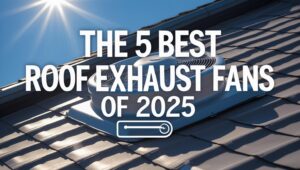5 Best Roof Exhaust Fans of 2025: Expert Reviews for a Cooler Home
Is your second floor unbearably hot in the summer? Are your cooling bills skyrocketing? The culprit might not be your AC unit—it could be a sweltering, poorly ventilated attic. Trapped heat and moisture in your attic can bake your home from the inside out, leading to premature roof aging, mold growth, and sky-high energy costs. The solution? An active ventilation system, and the heart of that system is a high-quality roof exhaust fan.
We’ve climbed the ladders, analyzed the specs, and listened to the hum of countless motors to bring you the definitive guide to the best roof exhaust fans for 2025. Whether you need a powerhouse electric fan, a silent solar model, or a smart, hybrid solution, we’ve got you covered.
1. QuietCool AFG PRO-3.0 Attic Gable Fan

The QuietCool AFG PRO-3.0 isn’t a roof-mount fan, but it’s our top pick for a reason: it’s an absolute beast of an attic fan that mounts in the gable vent, making installation far easier for most DIYers. It moves a massive amount of air, dramatically cooling your attic and, by extension, your entire home.
- Type: Electric Gable Mount
- CFM (Cubic Feet per Minute): Up to 2,880
- Coverage: Up to 3,000 sq. ft. attic
- Key Feature: Built-in thermostat and fire safety cut-off
Our Expert Take
Having installed several of these, I can attest to their raw power. The moment you turn it on, you can feel the air start to move. It’s particularly effective in homes with large, open attics where heat builds up intensely. A common question I get is, “Do metal roofs make your house hotter?” While they reflect heat well, the attic space underneath can still get incredibly hot, and a powerful fan like this is the perfect solution. The included thermostat is a must-have, ensuring it only runs when needed, saving you money.
Pros
- Extremely powerful air movement
- Energy-efficient permanent split capacitor motor
- Relatively easy DIY installation in a gable vent
- Includes adjustable thermostat for automatic operation
- Made in the USA with a 10-year warranty
Cons
- Not a roof-mounted fan, requires a gable vent
- Louder than smaller, solar-powered units
Best For: Large attics in extremely hot climates.
Check Price on Amazon2. Remington Solar 30-Watt Solar Attic Fan

For those looking for an eco-friendly, set-it-and-forget-it solution, the Remington Solar fan is a top contender. Powered entirely by the sun, this fan operates without any cost to your electricity bill. Its 30-watt panel is highly efficient, providing robust ventilation from dawn till dusk.
- Type: Solar Roof Mount
- CFM: Up to 1,550
- Coverage: Up to 2,500 sq. ft. attic
- Key Feature: Hybrid adapter available, brushless motor
Our Expert Take
Solar fans have come a long way, and the Remington is proof. The brushless motor is key here—it’s quiet and built for longevity. Installation is straightforward for anyone comfortable working on a roof. I appreciate the included humidistat and thermostat, which a lot of solar models skip. Aesthetically, it has a low profile, which is great. If you’re concerned about how it will look, remember you can always explore options for how to paint a metal roof to match components, though you should never paint the solar panel itself. This is a truly ‘free’ way to cool your attic once installed.
Pros
- Zero operational cost (100% solar powered)
- Qualifies for federal solar tax credits
- Very quiet brushless motor
- Includes thermostat and humidistat for smart operation
- Lifetime warranty on motor, 20 years on solar panel
Cons
- Only runs when there’s sufficient sunlight (hybrid adapter sold separately)
- Lower CFM than top-tier electric models
Best For: Eco-conscious homeowners in sunny climates.
Check Price on Amazon3. Broan-NuTone 356BR Powered Attic Ventilator

Sometimes you just need a dependable, no-frills workhorse. The Broan-NuTone 356BR is that fan. It’s a classic design from a trusted brand that has been clearing out hot attics for decades. The housing is galvanized steel, and the flashing is aluminum, built to withstand years of harsh weather.
- Type: Electric Roof Mount
- CFM: Up to 1,600
- Coverage: Up to 2,285 sq. ft. attic
- Key Feature: Heavy-duty construction, built-in thermostat
Our Expert Take
I’ve probably replaced more old Broan fans than any other brand, and that’s a compliment—they last for ages. The 356BR continues that legacy of durability. The key to its longevity is proper installation. You must ensure a perfect seal around the base. This involves understanding what is roof flashing and using the best roof sealant for the job. While it’s not the quietest fan on the market, its reliability is legendary. It’s a solid, middle-of-the-road choice that won’t let you down.
Pros
- Extremely durable steel dome and aluminum flashing
- Reliable performance from a reputable brand
- Moves a significant amount of air for its size
- Mesh bird screen is sturdy and effective
Cons
- Thermostat sold separately on some models (check listing)
- Can be louder than more modern designs
Best For: Homeowners seeking maximum durability and reliability.
Check Price on Amazon4. iLIVING Hybrid Smart Thermostat Solar Roof Fan

Can’t decide between solar and electric? The iLIVING Hybrid fan gives you the best of both worlds. It runs on solar power during the day and can automatically switch to AC power (with the included adapter) at night or on cloudy days, ensuring 24/7 attic ventilation. It’s the ultimate smart solution.
- Type: Hybrid Solar/Electric Roof Mount
- CFM: Up to 1,750
- Coverage: Up to 2,000 sq. ft. attic
- Key Feature: Included Smart Thermostat and AC adapter for hybrid operation
Our Expert Take
This is the future of attic ventilation. The flexibility of a hybrid system is a game-changer, especially in regions with variable weather. I’ve installed this for clients who were hesitant about going full-solar, and they love it. The included smart thermostat allows you to set it and forget it. The fan’s waterproof, brushless motor is exceptionally quiet. For those with complex rooflines, it’s important to place it correctly to avoid airflow issues, which is where understanding concepts like what is a roof cricket can be helpful for overall roof health. The iLIVING is a premium product with features that justify its price.
Pros
- Hybrid functionality for continuous operation
- High-efficiency brushless DC motor
- All necessary components (adapter, thermostat) included
- IP68 waterproof rating ensures durability
- Adjustable angle solar panel to maximize sun exposure
Cons
- Higher initial cost than single-power-source models
- Requires running electrical wiring for hybrid mode
Best For: Tech-savvy homeowners wanting 24/7 ventilation with solar benefits.
Check Price on Amazon5. Maxx Air-Ventilator Corp VX1000C2

If you’re on a budget but still need an effective ventilation solution, the Maxx Air VX1000C2 is an excellent choice. This is a simple, straightforward electric roof mount fan that gets the job done without any fancy bells and whistles. It’s ideal for smaller attics or as a cost-effective replacement for an old, broken unit.
- Type: Electric Roof Mount
- CFM: Up to 1,000
- Coverage: Up to 1,200 sq. ft. attic
- Key Feature: Great value for the price, galvanized steel construction
Our Expert Take
Don’t let the low price fool you; this is a capable little fan. It’s perfect for smaller homes, garages, or sheds. I’ve used these on many projects where the homeowner needed a functional solution without breaking the bank. Just like with any roof penetration, the key is a quality install. You’ll need the right tools, including one of the best roofing hammers, to secure it properly. While its 1,000 CFM rating isn’t massive, it’s more than enough for the recommended attic size and a huge improvement over passive vents alone.
Pros
- Very affordable price point
- Easy to install for those with basic roofing skills
- Durable construction for its price category
- Includes a thermostat
Cons
- Not powerful enough for large attics
- Noticeably louder than premium models
- Shorter warranty period than competitors
Best For: Smaller attics, garages, and budget-conscious buyers.
Check Price on AmazonFrequently Asked Questions (FAQs)
Do roof exhaust fans really work?
Absolutely. A properly sized and installed attic fan can lower attic temperatures by as much as 50°F. This reduces the heat load on your home’s insulation and AC system, potentially lowering your cooling costs by up to 30% and extending the life of your roof shingles.
Will a roof fan make my roof leak?
Only if installed incorrectly. A professional installation involves integrating the fan’s flashing with your roofing materials and using high-quality sealant to create a watertight seal. This is why understanding the role of components like the best roofing tape is important for a secure job.
How much does it cost to have a roof fan installed?
Installation costs vary by region and complexity, but you can generally expect to pay a professional between $300 and $600 for labor, in addition to the cost of the fan itself. It’s always a good idea to get a quote, which sometimes follows a general roof inspection cost structure.
Can I install a roof exhaust fan myself?
If you have experience with roofing, electrical work, and are comfortable with heights, it’s a manageable DIY project. However, due to the risks of leaks and personal injury, we recommend hiring a licensed professional if you have any doubts. Your safety is the top priority.
The Final Verdict: Beat the Heat in 2025
Investing in a roof exhaust fan is one of the smartest upgrades you can make for your home’s comfort, efficiency, and longevity. It’s a proactive step to combat extreme heat and protect your biggest asset.
For sheer power and performance in hot climates, the QuietCool AFG PRO-3.0 is our top recommendation. For a silent, eco-friendly, and cost-free operation, the Remington Solar 30-Watt fan is an unbeatable choice. And for those who want the ultimate in smart, 24/7 ventilation, the iLIVING Hybrid fan offers the best of all worlds.
Choose the fan that best fits your attic size, climate, and budget, and get ready to enjoy a cooler, more comfortable home this summer and for many years to come.

